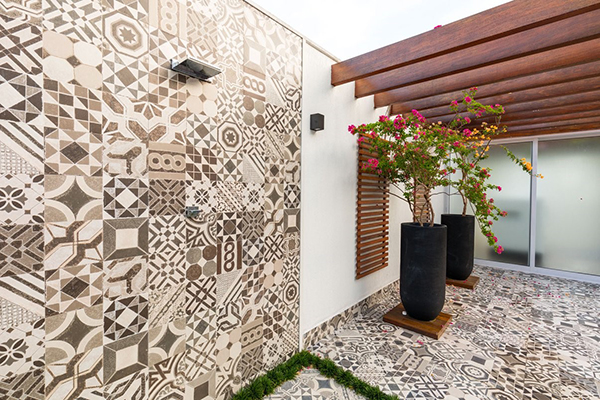
Flower trees: add a touch of color to the garden
Flowers have been an inspiration for architecture for a long time. We can see them in monumental buildings, such as the Lotus Temple, and works of spontaneous architecture, such as the Casa da Flor. With flower trees, you can have some of these works in your home, transforming the decoration into art inspired by nature.
On the streets, flower trees improve air quality, reduce temperatures and make the urban landscape more pleasant and sustainable. In the garden, they bring color and peace. See how you can bring them appropriately to the urban context and know which species are ideal for growing at home.
Bringing flower trees to the cities is essential to improve the quality of life in several aspects. In addition to natural beauty contributing to urban aesthetics, afforestation softens the climate and provides more climatic comfort.
In fact, trees bring not only thermal comfort - which is already a great help in urban centers, which have become true islands of heat over the years -, but also visual, acoustic and luminous.
ON TOURS AND SIDEWALKS

Small and medium sized trees can be placed on sidewalks and sidewalks, but they need authorization from the Chamber.
Anyone wishing to extend their garden outside and decorate the sidewalks and sidewalks with flower trees needs, first, authorization from the City Council.
The planting of an unsuitable tree for urban areas can cause bursting of ducts, elevation of sidewalks, fall of branches during gales, problems in the electrical network, heavy fruits that can fall on cars and people, and branches that hinder the passage.
Therefore, request the service and wait for authorization. Some chambers and parish councils already have urban afforestation planning.
ON TERRACES

See how beautiful these Bougainvilleas look great with the 60x60cm Gray Retro Wall cladding
In small houses and apartments, smaller and often pruned trees are the perfect choice (Project: Renata Faria Scherer).
On the terrace, the smaller, fast-growing plants are easier to care for, as they require less cleaning and maintenance.
To make care even easier, research is essential. Choose trees that do not have poisonous leaves, flowers or fruits, fragile wood, thorns and shallow and invasive roots.
FLOWERED TREES FOR FOOTWEAR AND GARDENS
Before investing in this type of tree, it is important to know which species do not destroy sidewalks or affect electrical cables. Here are some suggestions to make your garden much more colorful.
IPÊ-DE-GARDIM (TECOMA STANS)

Ornamental and fast growing, the ipe-de-jardim is very resistant
Ipês are generally large trees. In addition, they are very resistant to termites, which considerably reduces the risk of falls.
However, there is an alternative, the ipe-de-jardim which is small - grows from 4 to 6 m. It is ideal for hot places, such as the Algarve, as it requires full sun, but also tolerates frosts. In addition, its flowering is more intense in the hot period, although it can extend into autumn.
The leaves have serrated edges and the flowers are similar to those of the yellow ipe. It is an ornamental and fast growing tree.
The tree is spread by cuttings (planting small stem cuttings, roots or leaves in a humid environment) and seeds - which hinder the regeneration of spaces. Therefore, it is essential to be careful that it does not spread too much.
BUGANVILLE (BOUGAINVILLEA)

The bougainvillea in the shape of a tree or creeper gives color to any garden (Bougainvillea)
Although the most common color of this vine is violet, it is also common to find varieties in red, white or orange decorating facades of the Mediterranean or Atlantic coast. It is in these areas that it adapts best because the climate favors adaptation and development.
It loves full sun and prefers the walls near the coast and south orientation, but it can also be grown in pots or as a small tree. Planted on the ground it can become a very bulky specimen, with strong and spiny branches up to 10/12 meters high.
Therefore, it is necessary to tie the branches as they grow so that they are attached to the wall or the other chosen structure. The two most common species of bougainvillea are B. spectabilis and B. glabra.
But their characteristics are very similar: both are large, fast and easy to develop, perennial, oval and semi-fleshy leaves and huge sprigs of floral bracts that are grouped at the apex of the branches from the beginning of spring until winter.
AZALEA AND RHODODENDRON SPS.

See how beautiful these pots of pink and violet azaleas are combined with natural stones.
Most azaleas come from mountainous regions, where they enjoy a cool and humid climate, but you can grow them in any area, as long as they are in a suitable place. Above all, where the shade is constant: under big trees, on the west side of a wall or inside a courtyard they grow well and offer a magnificent color palette. Bearing the cold, they are the ideal solution to decorate the garden in winter, where you can plant them alone, combining varieties with flowers of different colors or next to other shrubs.
You don't like very dense shade but it is important that you stay part of the day under the sun. The best location is in a sun-shade area, under large trees that mitigate the effect of the sun's rays.
The soil must be abundant with organic matter. It is important to keep it moist but with adequate drainage to avoid waterlogging.
They are resistant plants, which can reach up to 2 meters in height, but are usually found in medium and mini varieties, ideal for vases and window sills.
MAGNOLIA (MAGNOLIA LILIFLORA)

When in bloom, the magnolia is one of the most lush trees to have in a garden.
For those who live in places of mild winter, the magnolia is one of the most suitable flowering trees. With a rounded crown and slow growth, it is large and can reach 5 m in height.
The flower petals are dense and in shades of pink, violet and white. When closed, they are shaped like tulips, and bloom in late winter, when the tree is leafless.
As the garden's only star, the magnolia is not the most suitable, as it loses its charm when it is not in bloom. However, it can be combined with other trees of cold tones or sets of green foliage that bloom throughout the year.
METROSIDERO EXCELSA SUN.

The Metrosidero is a very common tree in the Azores
Metrosidero is a persistent leaf tree, which can reach fertile and deep soils up to 20 m in height and as much in width. Because it accepts pruning very well, it is a plant that can be maintained with shrub size. It is a plant increasingly used to form dense hedges in more adverse environments. Its flower is red and appears between May and July, very attractive to bees due to the amount of nectar it contains.
The leaves are bright green at the top and light gray with a feather at the bottom.
It can also be called simply by metrosidero, fire tree or even New Zealand Christmas pine, since in the southern hemisphere the metrosidero fills with red flower in December and January.
PORCELAIN PLATES AND STONES FOR THE GARDEN
The garden with flowering trees is even more beautiful with porcelain tiles and or natural stone. They can give a classic look, when they reproduce marble, or rustic, when they are similar to wood or cement. In addition, they bring visual organization and remove the totally forest air from the environment.
See some models that you can find at Rubicer.
AUTHENTIQUE BOREAL 20X120

Porcelain tiles that imitate wood, such as the Authentique Boreal, combine with gardens and bring refinement to the space.
You can have an elegant and sustainable garden with a covering that only reproduces the texture of the wood. With Authentique Boreal, by Rubicer, it is possible to take the parquet floor to your garden, but with the ease of cleaning and durability of porcelain tiles.
MOTION 60x60cm

Motion porcelain tile has a surface that imitates cement in a 60x60cm format.
Ideal for floors, Motion porcelain tiles reproduce cement, giving a natural touch and making the combination in the gardens even more interesting. It can be used, for example, to separate trees into niches.
OUTDOOR AVALON 90x90cm

Another example of cement texture in a perfect symbiosis with the external environment. The Avalon of the Outdoor line, with its large format 90 × 90 looks spectacular on the outside and can be combined with the same texture in a natural finish for your living room.
To harmonize the trees and the porcelain tiles, the ideal is to count on the help of a landscaper. Through floor plans, 3D images of internal and external spaces and even hand drawings, he develops landscaping projects for his home.







